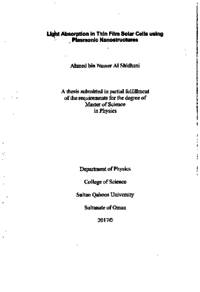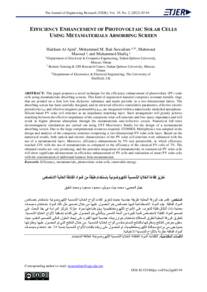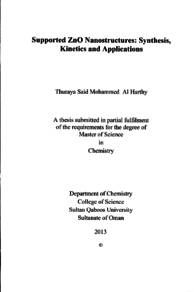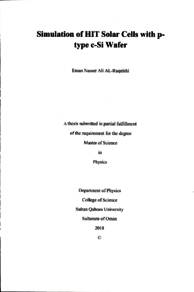Document
Light absorption in thin film solar cells using plasmonic nanostructures
Publisher
Sultan Qaboos University
Gregorian
2017
Language
English
English abstract
Thin-film silicon technology is a major candidate to react with the ever-increasing global energy demand. The small thickness of silicon allows high industrial output and low material usage and subsequently opens new paths to mass-production of low-cost solar cells. Thin film amorphous silicon (a-Si) solar cells suffer from weak absorption of long wavelength rays, which have absorption lengths that are far greater than the absorber layer thickness, hence there is a reduction in the efficiency in contrast to bulk Si cells. Light trapping schemes utilizing surface plasmons nanostructures (in addition to guided wave mode excitations) can strongly diffract long wavelength photons and increase their optical path length, causing improving the absorption in the active layer. Surface plasmons (SPs) are a light induced phenomenon resulting in desirable electromagnetic (EM) field enhancements concentrated at the surface of an appropriate dielectric-metal (or highly doped dielectric) interface. Free electrons in metals (or highly doped dielectric) can strongly interact with incident light to form Surface-Plasmon-Polaritons (SPPs). The resulting electromagnetic waves are trapped within sub-wavelength dimensions and can propagate along the interface. To efficiently use SPP propagation, their relatively short propagation length has to be enhanced. Hence, the SPs need to be optically excited using the diffraction grating method.
In this thesis, both top and bottom grating structures of solar cell designs are studied using commercial finite element analysis tool, COMSOL Multiphysics® software. The aim of this thesis is to investigate novel architecture combining two grating structure, leading to enhance absorption in thin film solar cells. The proposed model here is an active layer of amorphous silicon (a-Si), structured with two grating layers, one with the silicon dioxide (SiO2) on the top of it, the other is with titanium nitride (Tin) underneath of it. Numerical simulations by calculating the photocurrent enhancement were conducted to obtain the optimal geometry parameters of the proposed model. The double grating structure exhibits an improvement in absorption up to 3.4 times comparing with that of the planar structure over a wide range of incident light wavelength. This directly causes an enhancement of 1.34 of the short circuit current density. The parametric studies also indicated that the absorption enhancement of such architecture is a little sensitive to the angle of incidence. Extensive numerical simulations of various designs with changed materials and gratings shape may done to achieve better performance and lower the cost of the solar cell design.
Member of
Resource URL
Arabic abstract
تعتبر تكنلوجيا الأغشية الرقيقة المصنوعة من السليكون عاملا أساسيا في مواجهة الحاجة المتزايدة للطاقة في العالم. يسمح السيليكون ذو السمك الصغير بزيادة الإنتاج الصناعي واستخدام كمية قليلة من المادة مما يؤدي إلى فتح أبوابا لزيادة حجم إنتاج خلايا شمسية قليلة الكلفة. إن هذه الأغشية الرقيقة التي تصنع من السليكون غير المتبلور ( a - Si ) تعاني ضعفا في امتصاص الضوء ذو الطول الموجي العالي التي تحتاج إلى طول امتصاص أكبر بكثير من سمك طبقة الامتصاص النشطة، لذلك فإن كفاءتها تكون أقل من كفاءة خلايا السيليكون الشمسية التقليدية.
إن نماذج حصر الضوء باستعمال ما يعرف ب البلازمونات السطحية (SPs) وتوظيف هندسة النانو (nanostructures) (بالإضافة إلى إثارة نمط الموجة الموجهة) يمكن أن تحيد الضوء ذو الطول الموجي العالي بقوة وتزيد طول مسارها الضوئي ، مما يؤدي إلى تحسين الامتصاص في الطبقة النشطة. البلازمونات السطحية (SPs) هي ظاهرة ضوء محتث تنتج مجال كهرومغناطيسي (EM) محسن ومركز في السطح البيني المناسب بين مادة عازلة ومادة فلزية (أو مادة عازلة عالية التطعيم). إن الالكترونات الحرة في الفلزات (أو في المواد العازلة عالية التطعيم) يمكن أن تتفاعل بقوة مع الضوء الساقط لتكوين ما يعرف با بولاريتونات البلازمونات السطحية (SPPs). تنحصر هذه الموجات الكهرومغناطيسية الناتجة ضمن أبعاد أطوال موجية فرعية ويمكنها أن تنتقل عبر السطح البيني للمواد. وللاستفادة من كفاءة انتشار هذه البولاريتونات، يجب أن تحسن طول انتشارها القصير نسبية. لذلك فإن البلازمونات السطحية تحتاج أن تثار بصريا باستخدام طريقة مشبك الحيود.
في هذا البحث، تمت دراسة كلا من مشبك الحيود السفلي والعلوي في نماذج الخلايا الشمسية باستعمال برنامج المحاكاة التجاري ® OMSOL Multiphysics. الهدف من هذه الأطروحة هو التحقق من أسلوب C هندسي مبتكر يجمع بين مشبك الحيود السفلي والعلوي للتوصل إلى تحسين الامتصاص في الأغشية الشمسية الرقيقة. النموذج المقترح عبارة عن طبقة نشطة من السيليكون غير المتبلور ( a- Si) مرتبط بمشبك حيود مع طبقة ثاني أكسيد السيليكون (SiO2) العلوية، وبمشبك حيود آخر مع طبقة نيتريد التيتانيوم (TiN) السفلية.
أجرت الدراسة تجارب محاكاة رقمية بحساب الزيادة في التيار الناشئ من الخلية لأجل استنتاج المتغيرات الهندسية المثلى للنموذج المقترح. أظهر نموذج المشبك المزدوج زيادة في الامتصاص بمقدار 34 مرة مقارنة مع نفس النموذج بدون المشابك على مدى واسع من الطول الموجي للضوء الساقط. هذا يؤدي مباشرة إلى تحسين في قيمة كثافة التيار بمقدار. 1. 34 مرة مقارنة بالنموذج الأصلي. كما أشارت هذه الدراسة أيضا أن تحسين الامتصاص في مثل هذه الأساليب الهندسية لا يتأثر كثيرا بزاوية سقوط الضوء. دراسة نماذج رقمية معمقة على تصميمات مختلفة من المواد وشكل المشبك، قد تؤدي إلى تحقيق م ي ع تقليل كلفة نماذج الخلايا الشمسية.
إن نماذج حصر الضوء باستعمال ما يعرف ب البلازمونات السطحية (SPs) وتوظيف هندسة النانو (nanostructures) (بالإضافة إلى إثارة نمط الموجة الموجهة) يمكن أن تحيد الضوء ذو الطول الموجي العالي بقوة وتزيد طول مسارها الضوئي ، مما يؤدي إلى تحسين الامتصاص في الطبقة النشطة. البلازمونات السطحية (SPs) هي ظاهرة ضوء محتث تنتج مجال كهرومغناطيسي (EM) محسن ومركز في السطح البيني المناسب بين مادة عازلة ومادة فلزية (أو مادة عازلة عالية التطعيم). إن الالكترونات الحرة في الفلزات (أو في المواد العازلة عالية التطعيم) يمكن أن تتفاعل بقوة مع الضوء الساقط لتكوين ما يعرف با بولاريتونات البلازمونات السطحية (SPPs). تنحصر هذه الموجات الكهرومغناطيسية الناتجة ضمن أبعاد أطوال موجية فرعية ويمكنها أن تنتقل عبر السطح البيني للمواد. وللاستفادة من كفاءة انتشار هذه البولاريتونات، يجب أن تحسن طول انتشارها القصير نسبية. لذلك فإن البلازمونات السطحية تحتاج أن تثار بصريا باستخدام طريقة مشبك الحيود.
في هذا البحث، تمت دراسة كلا من مشبك الحيود السفلي والعلوي في نماذج الخلايا الشمسية باستعمال برنامج المحاكاة التجاري ® OMSOL Multiphysics. الهدف من هذه الأطروحة هو التحقق من أسلوب C هندسي مبتكر يجمع بين مشبك الحيود السفلي والعلوي للتوصل إلى تحسين الامتصاص في الأغشية الشمسية الرقيقة. النموذج المقترح عبارة عن طبقة نشطة من السيليكون غير المتبلور ( a- Si) مرتبط بمشبك حيود مع طبقة ثاني أكسيد السيليكون (SiO2) العلوية، وبمشبك حيود آخر مع طبقة نيتريد التيتانيوم (TiN) السفلية.
أجرت الدراسة تجارب محاكاة رقمية بحساب الزيادة في التيار الناشئ من الخلية لأجل استنتاج المتغيرات الهندسية المثلى للنموذج المقترح. أظهر نموذج المشبك المزدوج زيادة في الامتصاص بمقدار 34 مرة مقارنة مع نفس النموذج بدون المشابك على مدى واسع من الطول الموجي للضوء الساقط. هذا يؤدي مباشرة إلى تحسين في قيمة كثافة التيار بمقدار. 1. 34 مرة مقارنة بالنموذج الأصلي. كما أشارت هذه الدراسة أيضا أن تحسين الامتصاص في مثل هذه الأساليب الهندسية لا يتأثر كثيرا بزاوية سقوط الضوء. دراسة نماذج رقمية معمقة على تصميمات مختلفة من المواد وشكل المشبك، قد تؤدي إلى تحقيق م ي ع تقليل كلفة نماذج الخلايا الشمسية.
Category
Theses and Dissertations





